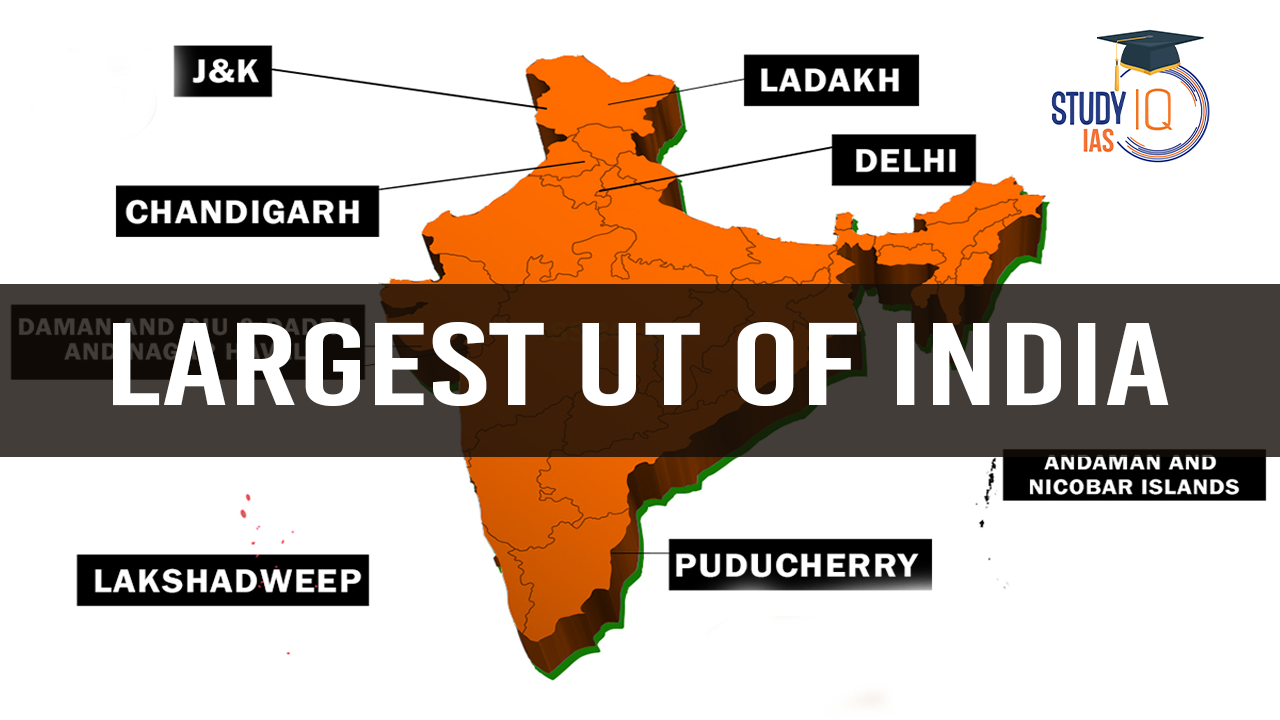Table of Contents
Largest UT of India: India, the seventh-largest country in the world, consists of 28 states and 8 Union Territories (UTs). Among these UTs, Ladakh is the largest in terms of area. Spanning over 59,146 square kilometers, Ladakh was carved out from Jammu and Kashmir on October 31, 2019, following the abrogation of Article 370. It is a region known for its breathtaking landscapes, strategic significance, and unique cultural heritage.
Largest UT of India – Ladakh
Ladakh is located in the northernmost part of India, sharing borders with China (Tibet Autonomous Region) to the east, Pakistan-administered Gilgit-Baltistan to the west, and the Indian state of Himachal Pradesh to the south. The region is sparsely populated, with a population of around 2.74 lakh (as per the 2011 Census), making it one of the least populated UTs in India.
| Feature | Details |
|---|---|
| Established | October 31, 2019 |
| Capital | Leh (summer), Kargil (winter) |
| Total Area | 59,146 sq. km |
| Population | 2.74 lakh (Census 2011) |
| Districts | 2 (Leh and Kargil) |
| Languages | Ladakhi, Balti, Hindi, Urdu, English |
| Borders | China (Tibet), Pakistan (PoK), Himachal Pradesh, Jammu & Kashmir |
Geographical Significance
Ladakh is located in the northernmost part of India, surrounded by the Karakoram and Himalayan ranges. It is known for its cold desert climate and high-altitude lakes such as Pangong Lake and Tso Moriri.
Key Geographic Features:
- Mountain Passes: Includes Khardung La (one of the highest motorable passes), Chang La, and Zoji La.
- Rivers: Indus River, Zanskar River, and Shyok River.
- Lakes: Pangong Tso, Tso Moriri, Tso Kar.
- Glaciers: Siachen Glacier, Drang-Drung Glacier.
Historical Background
Ladakh has a rich history of Buddhist and Tibetan influences. It was once a part of the Silk Route trade network and has been a significant cultural and religious center. The region was integrated into the Kingdom of Jammu and Kashmir in 1846 and later became a Union Territory in 2019.
Strategic Importance
Ladakh shares borders with China (Tibet Autonomous Region) and Pakistan (Gilgit-Baltistan), making it strategically vital for India’s defense. The region has witnessed conflicts such as the Indo-Pakistani Wars and the recent India-China border tensions in Galwan Valley.
Key Military Installations:
- Siachen Glacier – The world’s highest battlefield.
- Leh Airbase – Critical for defense operations.
- Border Roads and Highways – Infrastructure projects like the Atal Tunnel and Zojila Tunnel enhance connectivity.
Economy and Livelihood
Ladakh’s economy is primarily based on tourism, agriculture, and handicrafts.
Key Economic Sectors:
- Tourism: Ladakh is famous for its monasteries, trekking routes, adventure sports, and festivals.
- Agriculture: Barley, wheat, and apples are grown in the fertile valleys.
- Handicrafts: Pashmina wool, Thangka paintings, and apricot-based products are popular.
- Renewable Energy: Ladakh is being developed as a solar energy hub.
Cultural and Religious Diversity
Ladakh is a melting pot of Buddhist and Islamic influences. The majority of the population follows Buddhism, with significant Muslim communities in Kargil.
Major Festivals:
- Hemis Festival – Celebrated at Hemis Monastery.
- Losar Festival – Tibetan New Year.
- Sindhu Darshan Festival – Celebrates the Indus River.
Prominent Monasteries:
- Hemis Monastery
- Thiksey Monastery
- Diskit Monastery
- Alchi Monastery
Connectivity and Infrastructure
Ladakh is accessible by air and road. The main transport routes include:
- Kushok Bakula Rimpochee Airport (Leh) – The main airport of Ladakh.
- Srinagar-Leh Highway – Connects Ladakh with Jammu & Kashmir.
- Manali-Leh Highway – Connects Ladakh with Himachal Pradesh.
- Upcoming Projects – Zojila Tunnel and improved road networks for better connectivity.
Conclusion
Ladakh, the largest Union Territory of India, is a land of extreme beauty, cultural heritage, and strategic significance. With its breathtaking landscapes, historical richness, and economic potential, Ladakh continues to be a region of great national importance. The government’s focus on infrastructure, renewable energy, and tourism will further enhance its growth and development.


 Governor's Assent to State Laws and Bill...
Governor's Assent to State Laws and Bill...
 Strengthening Enforcement of Judicial Or...
Strengthening Enforcement of Judicial Or...
 Gradual Transformation of the Ministry o...
Gradual Transformation of the Ministry o...





















